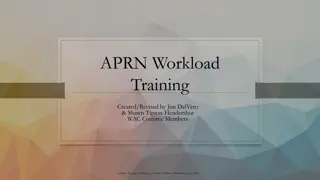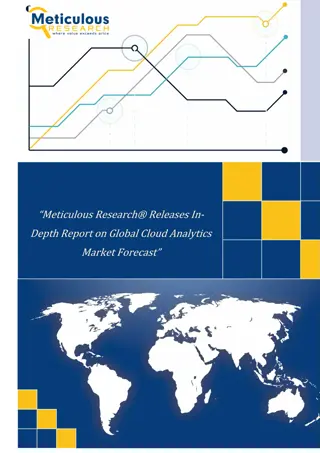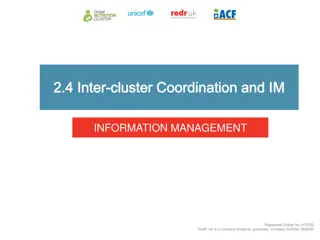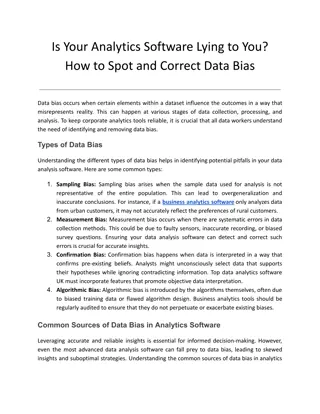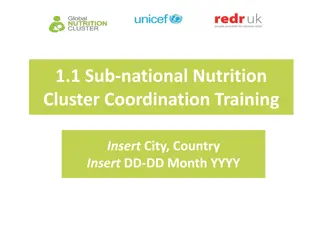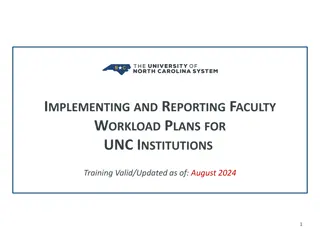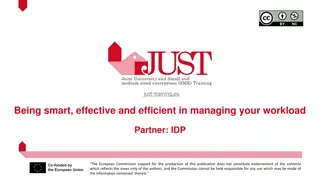Enhancing Cluster Management for User-Centric Workload Analytics
Shared computing clusters at universities and government labs face challenges due to varying user expertise and needs. This project aims to provide customer-centric analytics to enhance cluster availability and performance, addressing issues such as job failures and system usage data availability. Details of Purdue and LLNL clusters, along with cluster scheduling policies, are discussed.
Uploaded on Feb 28, 2025 | 2 Views
Download Presentation

Please find below an Image/Link to download the presentation.
The content on the website is provided AS IS for your information and personal use only. It may not be sold, licensed, or shared on other websites without obtaining consent from the author.If you encounter any issues during the download, it is possible that the publisher has removed the file from their server.
You are allowed to download the files provided on this website for personal or commercial use, subject to the condition that they are used lawfully. All files are the property of their respective owners.
The content on the website is provided AS IS for your information and personal use only. It may not be sold, licensed, or shared on other websites without obtaining consent from the author.
E N D
Presentation Transcript
User-Centric Workload Analytics: Towards Better Cluster Management Saurabh Bagchi Purdue University Supported by National Science Foundation (NSF) Jul `15-Jul `18 Joint work with: Subrata Mitra, Suhas Javagal, Stephen Harrell (Purdue), Adam Moody, Todd Gamblin (LLNL) Presentation available at: engineering.purdue.edu/dcsl Slide 1
Problem Context Shared computing clusters at university or government labs is not uncommon Users have a varying level of expertise Writing own job scripts Using scripts like a black box Varying user needs High computation power Analysis of large structures (Civil, Aerospace engineering) High Lustre bandwidth for file operations Working with multiple large databases/files (Genomics) High Network Bandwidth A parallel processing application Slide 2
Motivation Challenge for the cluster management Need for customer centric analytics to pro-actively help users Improve cluster availability In addition to failures, investigate performance issues in jobs Need for open data repository of system usage data Currently, lack of publicly available, annotated quantitative data for analyzing workloads Available public data sets provide only system level information and not up-to-date Dataset must not violate user privacy or IT security concerns URL: https://github.com/purdue-dcsl/fresco Slide 3
Cluster Details: Purdue Purdue s cluster is called Conte Conte is a ``Community cluster 580 homogeneous nodes Each node contains two 8 core Intel Xeon E5-2670 Sandy Bridge processors running at 2.6 GHz Two Xeon Phi 5110P accelerator card, each with 60 cores Memory: 64GB of DDR3, 1.6 GHz RAM 40 Gbps FDR10 Infiniband interconnect along with IP Lustre file system, 2GB/s RHEL 6.6 PBS based job scheduling using Torque Slide 4
Cluster Details: LLNL SLURM: Job Scheduler TOSS 2.2 OS 16-core Intel Xeon processors (Cab) 12-core Intel Xeon processors (Sierra) 32GB memory (Cab) 24GB memory (Sierra) 1296 nodes (Cab) and 1944 nodes (Sierra) Infiniband network Slide 5
Cluster Policies Scheduling: Each job requests for certain time duration, number of nodes and in some cases, amount of memory needed When job exceeds the specified time limit, it is killed Jobs are also killed by out-of-memory (OOM) killer scripts, if it exhausts available physical memory and swap space Node sharing: By default only a single job is scheduled on a an entire node giving dedicated access to all the resources However, user can enable sharing by using a configuration in the job submission scripts Slide 6
Data Set Accounting logs from the job scheduler, TORQUE Node-level performance statistics from TACC stats CPU, Lustre, Infiniband, Virtual memory, Memory and more Library list for each job, called liblist Job scripts submitted by users Syslog messages Summary Conte Data set duration Oct 14 Mar 15 Cab and Sierra May 15 Nov 15 Total number of jobs 489,971 247,888 and 227,684 374 and 207 Number of users URL: https://github.com/purdue-dcsl/fresco 306 Slide 7
Analysis: Types of Jobs (A) (B) LLNL cluster Purdue cluster Different job sizes Purdue has a large number of narrow jobs LLNL jobs span hundreds to thousands of processes Slide 8
Analysis: Requested versus Actual Runtime Purdue cluster LLNL cluster Users have little clue how much runtime to request Purdue: 45% of jobs used less than 10% of requested time LLNL: 15% of jobs used less than 1% of requested time Consequence: Insufficient utilization of computing resources Slide 9
Analysis: Resource Usage by App Groups Infiniband read rate on Conte Lustre read rate on Conte Memory usage on Conte Clearly, there are 2 distinct types of jobs Few jobs need high bandwidth backplane for Network and IO In case of memory, such a distinction is not present Follow-on: Specialized cluster built in 2015 for high resource demands Has 56 GBps Infiniband network Slide 10
Analysis: Performance Issues due to Memory Find a (quantitative) threshold on major page fault rate Find all jobs (and job owners) which exceed the threshold In the extreme, memory exhaustion leads to invocation of oom-killer, kernel level memory manager Multiple evidence for memory problems: Syslog messages with out-of-memory (OOM) code and application exit code 92% of jobs with memory exhaustion logged OOM messages 77% of jobs with OOM messages had memory exhaustion exit code Slide 11
Current status of the repository Workload traces from Purdue cluster Accounting information (Torque logs) TACC stats performance data User documentation Privacy Anonymize machine specific information Anonymize user/group identifiers Library list is not shared For privacy reasons URL: https://github.com/purdue-dcsl/fresco Slide 12
Conclusion It is important to analyze how resources are being utilized by users Scheduler tuning, resource provisioning, and educating users It is important to look at workload information together with failure events Workload affects the kinds of hardware-software failures that are triggered Open repository started with the goal for different kind of analyses to enhance system dependability URL: https://github.com/purdue-dcsl/fresco Slide 13





